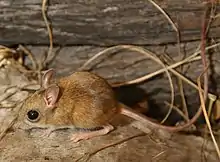Northern hopping mouse
The northern hopping mouse (Notomys aquilo) is a species of rodent in the family Muridae. It is found only in coastal northern Australia, from Arnhem Land to the Cobourg Peninsula.
| Northern hopping mouse | |
|---|---|
 | |
| N. aquilo at Wurruwarrkbadenumanja, Groote Eylandt | |
| Scientific classification | |
| Domain: | Eukaryota |
| Kingdom: | Animalia |
| Phylum: | Chordata |
| Class: | Mammalia |
| Order: | Rodentia |
| Family: | Muridae |
| Genus: | Notomys |
| Species: | N. aquilo |
| Binomial name | |
| Notomys aquilo Thomas, 1921 | |
This mouse weighs 25 to 30 grams and is brown above and white below. Its long tail measures 150% of its body length and it has long hind feet up to 4 centimeters long.[2]
This species lives in sandy soils on heathlands and grasslands. It is nocturnal. It consumes seeds and sometimes other plant material and invertebrates.[2] The mouse hops, leaving bipedal tracks.[3] Several individuals live communally in burrows.[2][3]
Threats to this species include habitat alteration, such as changes in the fire regime and the effects of livestock. Feral cats watch the burrows and may consume several individuals in a night.[3]
References
- Woinarski, J.; Burbidge, A.A. (2016). "Notomys aquilo". IUCN Red List of Threatened Species. 2016: e.T14862A22401364. doi:10.2305/IUCN.UK.2016-2.RLTS.T14862A22401364.en. Retrieved 15 November 2021.
- Notomys aquilo. Archived 2011-03-28 at the Wayback Machine Northern Territory Government Department of Natural Resources, Environment, and the Arts.
- Notomys aquilo. Archived 2011-08-16 at the Wayback Machine Queensland Government Environment and Resource Management.
External links
- Musser, G.G.; Carleton, M.D. (2005). "Superfamily Muroidea". In Wilson, D.E.; Reeder, D.M (eds.). Mammal Species of the World: A Taxonomic and Geographic Reference (3rd ed.). Johns Hopkins University Press. pp. 894–1531. ISBN 978-0-8018-8221-0. OCLC 62265494.
- Jones, Ann (14 March 2015). "The engineering mouse builds its dream house". Off Track. ABC Radio National.
- "Notomys aquilo". NCBI Taxonomy Browser. 442588.
